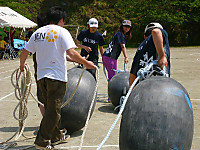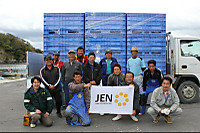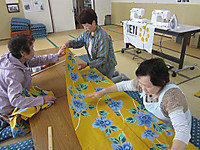By Miyako Hamasaki | Manager, External Relations
Project
Relief & Re-establishment activities for those affected by the Tohoku Pacific Area Earthquake
Target Area
Miyagi Prefecture, Ishinomaki City and nearby villages
Activities during May & June 2012
[Community Space]
Community Reconstruction and assistance has been conducted mainly through the establishing of “Community Spaces”, which offer psychological support and a wide variety of social activities. Recent examples of the latter have taken forms such as yoga classes, hand massages, and make-up lessons in locations such as HANA House, a community café in the Kitsuma-Minami district. HANA House is one of the three community cafes that were run by local inhabitants by the end of 2011. JEN strongly believes that communities can be rebuilt through the cooperation and participation of supporters and locals in such centers of interaction, by providing platforms for social events, as well as psycho-emotional care.
Other noteworthy events organized by JEN for the purposes of community reconstruction during the months of May and June have included a sports meeting for primary school and kindergarten children, and a kimono sewing event in preparation for the approaching summer festival season, for which such costumes are traditionally worn. JEN will continue to initiate community reconstruction by organizing interactive events in centers of psycho-social assistance.
[Mudbusters are turning into…]
JEN has been continuing to recruit volunteers from the public, and its volunteer dispatch program has succeeded in coordinating over 4000 participants in cleaning operations of sludge and debris. These activities have begun to shift in emphasis from ‘emergency relief’ work involving manual labor such as the transporting of supplies to temporary housing from the JEN volunteer dispatch program, to ‘reconstruction assistance’ which focuses on the revitalization of the fishery industry and supporting the daily lives of people living in temporary housing. The latter is typified by projects such as the training program conducted by the 184 new recruits of the Ricoh Company, Ltd. in June. This crew was divided into three groups and worked on creating sandbags, scraping holdfasts off kelps, and sorting kelps and seaweed. These sandbags can be utilized effectively in almost all aquaculture facilities, and thus are of great value to local fishery, which JEN recognised as the economic backbone of the community. The goal on this particular occasion was to produce 8000 sandbags, but the new recruits managed to exceed this goal substantially by 1,622 bags.
[Income Generation]
Restoration of livelihood is a crucial necessity in Ishinomaki city and its surrounding villages. JEN have been engaged in a variety of fishery support activities in Ishinomaki city since last year, in order to facilitate the recovery of its primary means of economy. Currently, there is a critical lack of equipment crucial to those engaging in coastal fishing activities in fisheries. Since February, JEN have been able to supply skytanks, a forklift truck, palettes, a kelp cropping machine and plastic catches containers to ten fisheries afflicted by the tsunami.
Another job creation project JEN has initiated in attempting to revive the fishery industry has been its supplying of fishing nets specifically for mantis fishing, which suffered greatly due to almost all of the said nets having been swept away by the tsunami. Such nets have been in short supply and hence the fishermen have had serious difficulties regenerating one of their main means of livelihood. JEN has established a system in which locals are taught how to manufacture the nets, which are in turn bought by JEN and provided to the fishermen through the Fisheries Cooperative Association. JEN believes establishing such productive cycles is one of the most sustainable approaches in contributing towards long-term solutions of the local industry, in that it benefits not just the fishermen but also those who produce the nets. Furthermore, this technology and skill can in turn be passed down through generations thereby promoting future commerce as well as intergenerational exchange.
Project reports on GlobalGiving are posted directly to globalgiving.org by Project Leaders as they are completed, generally every 3-4 months. To protect the integrity of these documents, GlobalGiving does not alter them; therefore you may find some language or formatting issues.
If you donate to this project or have donated to this project, you can receive an email when this project posts a report. You can also subscribe for reports without donating.


